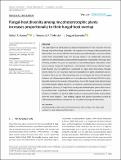| dc.contributor.author | Gomes, Sofia I. F. | |
| dc.contributor.author | Merckx, Vincent S. F. T. | |
| dc.contributor.author | Saavedra Sanchez, Serguei | |
| dc.date.accessioned | 2018-05-01T18:20:20Z | |
| dc.date.available | 2018-05-01T18:20:20Z | |
| dc.date.issued | 2017-03 | |
| dc.date.submitted | 2017-02 | |
| dc.identifier.issn | 2045-7758 | |
| dc.identifier.uri | http://hdl.handle.net/1721.1/115139 | |
| dc.description.abstract | The vast majority of plants obtain an important proportion of vital resources from soil through mycorrhizal fungi. Generally, this happens in exchange of photosynthetically fixed carbon, but occasionally the interaction is mycoheterotrophic, and plants obtain carbon from mycorrhizal fungi. This process results in an antagonistic interaction between mycoheterotrophic plants and their fungal hosts. Importantly, the fungal‐host diversity available for plants is restricted as mycoheterotrophic interactions often involve narrow lineages of fungal hosts. Unfortunately, little is known whether fungal‐host diversity may be additionally modulated by plant–plant interactions through shared hosts. Yet, this may have important implications for plant competition and coexistence. Here, we use DNA sequencing data to investigate the interaction patterns between mycoheterotrophic plants and arbuscular mycorrhizal fungi. We find no phylogenetic signal on the number of fungal hosts nor on the fungal hosts shared among mycoheterotrophic plants. However, we observe a potential trend toward increased phylogenetic diversity of fungal hosts among mycoheterotrophic plants with increasing overlap in their fungal hosts. While these patterns remain for groups of plants regardless of location, we do find higher levels of overlap and diversity among plants from the same location. These findings suggest that species coexistence cannot be fully understood without attention to the two sides of ecological interactions. Keywords:
mycoheterotrophic interactions; mycorrhizal cheaters; niche overlap; niche width; plant coexistence; plant–belowground interactions | en_US |
| dc.publisher | Wiley-Blackwell | en_US |
| dc.relation.isversionof | http://dx.doi.org/10.1002/ECE3.2974 | en_US |
| dc.rights | Creative Commons Attribution 4.0 International License | en_US |
| dc.rights.uri | http://creativecommons.org/licenses/by/4.0/ | en_US |
| dc.source | Wiley | en_US |
| dc.title | Fungal-host diversity among mycoheterotrophic plants increases proportionally to their fungal-host overlap | en_US |
| dc.type | Article | en_US |
| dc.identifier.citation | Gomes, Sofia I. F. et al. “Fungal-Host Diversity Among Mycoheterotrophic Plants Increases Proportionally to Their Fungal-Host Overlap.” Ecology and Evolution 7, 10 (April 2017): 3623–3630 © 2017 The Authors | en_US |
| dc.contributor.department | Massachusetts Institute of Technology. Department of Civil and Environmental Engineering | en_US |
| dc.contributor.mitauthor | Saavedra Sanchez, Serguei | |
| dc.relation.journal | Ecology and Evolution | en_US |
| dc.eprint.version | Final published version | en_US |
| dc.type.uri | http://purl.org/eprint/type/JournalArticle | en_US |
| eprint.status | http://purl.org/eprint/status/PeerReviewed | en_US |
| dc.date.updated | 2018-04-24T17:39:42Z | |
| dspace.orderedauthors | Gomes, Sofia I. F.; Merckx, Vincent S. F. T.; Saavedra, Serguei | en_US |
| dspace.embargo.terms | N | en_US |
| mit.license | PUBLISHER_CC | en_US |
